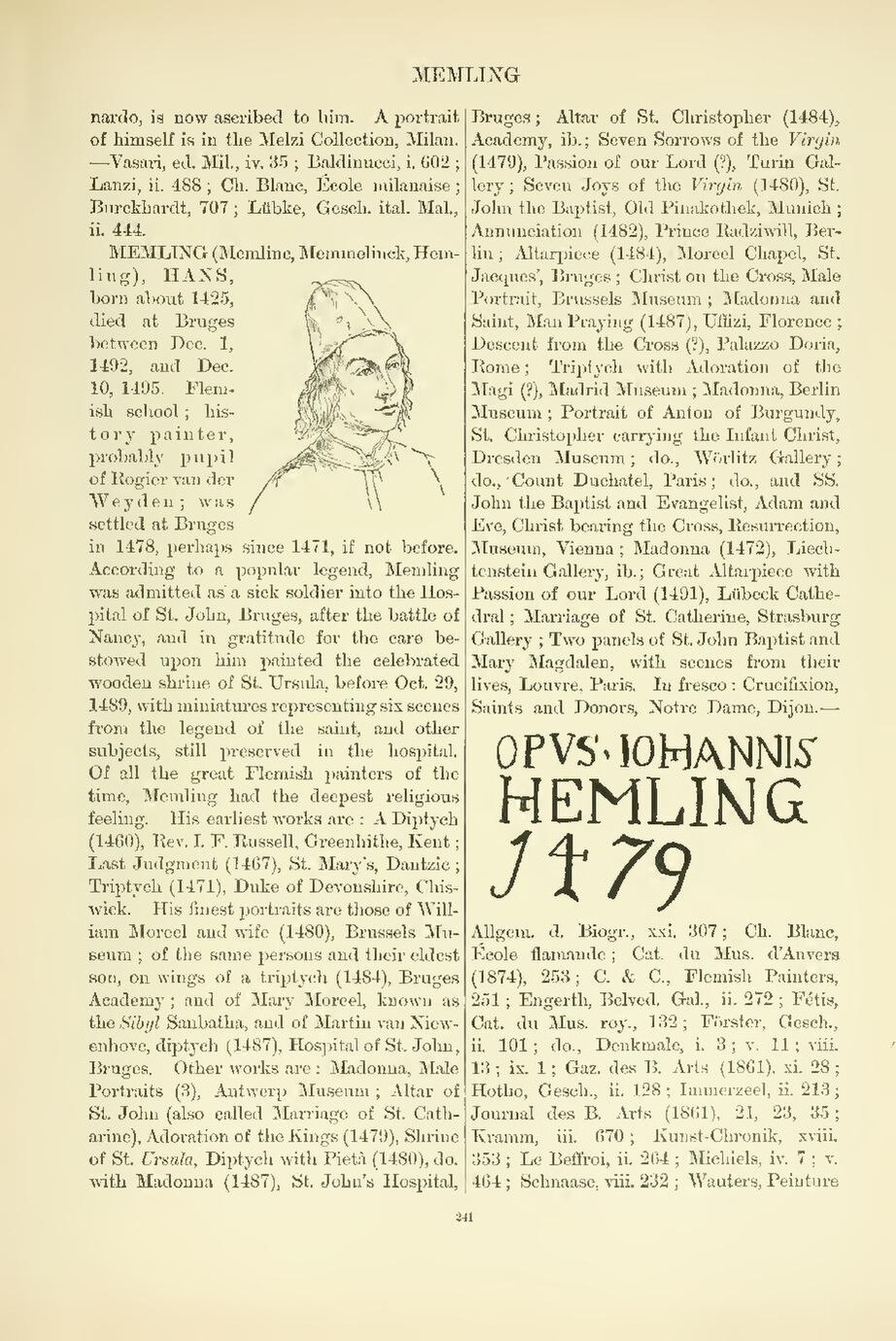- nardo, is now ascribed to him. A portrait
of himself is in the Melzi Collection, Milan.—Vasari, ed. Mil., iv. 35; Baldinucci, i. 602; Lanzi, ii. 488; Ch. Blanc, École milanaise; Burckhardt, 707; Lübke, Gesch. ital. Mal., ii. 444.
An image should appear at this position in the text. To use the entire page scan as a placeholder, edit this page and replace "{{missing image}}" with "{{raw image|Cyclopedia of painters and paintings (IA cyclopediaofpain03cham).pdf/263}}". Otherwise, if you are able to provide the image then please do so. For guidance, see Wikisource:Image guidelines and Help:Adding images. |
An image should appear at this position in the text. To use the entire page scan as a placeholder, edit this page and replace "{{missing image}}" with "{{raw image|Cyclopedia of painters and paintings (IA cyclopediaofpain03cham).pdf/263}}". Otherwise, if you are able to provide the image then please do so. For guidance, see Wikisource:Image guidelines and Help:Adding images. |
MEMLING (Memlinc, Memmelinck, Hemling),
HANS,
born about 1425,
died at Bruges
between Dec. 1,
1492, and Dec.
10, 1495. Flemish
school; history
painter,
probably pupil
of Rogier van der
Weyden; was
settled at Bruges
in 1478, perhaps since 1471, if not before.
According to a popular legend, Memling
was admitted as a sick soldier into the Hospital
of St. John, Bruges, after the battle of
Nancy, and in gratitude for the care bestowed
upon him painted the celebrated
wooden shrine of St. Ursula, before Oct. 29,
1489, with miniatures representing six scenes
from the legend of the saint, and other
subjects, still preserved in the hospital.
Of all the great Flemish painters of the
time, Memling had the deepest religious
feeling. His earliest works are: A Diptych
(1460), Rev. I. F. Russell, Greenhithe, Kent;
Last Judgment (1467), St. Mary's, Dantzic;
Triptych (1471), Duke of Devonshire, Chiswick.
His finest portraits are those of William
Moreel and wife (1480), Brussels Museum;
of the same persons and their eldest
son, on wings of a triptych (1484), Bruges
Academy; and of Mary Moreel, known as
the Sibyl Sanbatha, and of Martin van Niewenhove,
diptych (1487), Hospital of St. John,
Bruges. Other works are: Madonna, Male
Portraits (3), Antwerp Museum; Altar of
St. John (also called Marriage of St. Catharine),
Adoration of the Kings (1479), Shrine
of St. Ursula, Diptych with Pietà (1480), do.
with Madonna (1487), St. John's Hospital,
Bruges; Altar of St. Christopher (1484),
Academy, ib.; Seven Sorrows of the Virgin
(1479), Passion of our Lord (?), Turin Gallery;
Seven Joys of the Virgin (1480), St.
John the Baptist, Old Pinakothek, Munich;
Annunciation (1482), Prince Radziwill, Berlin;
Altarpiece (1484), Moreel Chapel, St.
Jacques', Bruges; Christ on the Cross, Male
Portrait, Brussels Museum; Madonna and
Saint, Man Praying (1487), Uffizi, Florence;
Descent from the Cross (?), Palazzo Doria,
Rome; Triptych with Adoration of the
Magi (?), Madrid Museum; Madonna, Berlin
Museum; Portrait of Anton of Burgundy,
St. Christopher carrying the Infant Christ,
Dresden Museum; do., Wörlitz Gallery;
do., Count Duchatel, Paris; do., and SS.
John the Baptist and Evangelist, Adam and
Eve, Christ bearing the Cross, Resurrection,
Museum, Vienna; Madonna (1472), Liechtenstein
Gallery, ib.; Great Altarpiece with
Passion of our Lord (1491), Lübeck Cathedral;
Marriage of St. Catherine, Strasburg
Gallery; Two panels of St. John Baptist and
Mary Magdalen, with scenes from their
lives, Louvre, Paris. In fresco: Crucifixion,
Saints and Donors, Notre Dame, Dijon.—Allgem.
d. Biogr., xxi. 307; Ch. Blanc,
École flamande; Cat. du Mus. d'Anvers
(1874), 253; C. & C., Flemish Painters,
251; Engerth, Belved. Gal., ii. 272; Fétis,
Cat. du Mus. roy., 132; Förster, Gesch.,
ii. 101; do., Denkmale, i. 3; v. 11; viii.
13; ix. 1; Gaz. des B. Arts (1861), xi. 28;
Hotho, Gesch., ii. 128; Immerzeel, ii. 213;
Journal des B. Arts (1861), 21, 23, 35;
Kramm, iii. 670; Kunst-Chronik, xviii.
353; Le Beffroi, ii. 264; Michiels, iv. 7; v.
464; Schnaase, viii. 232; Wauters, Peinture
